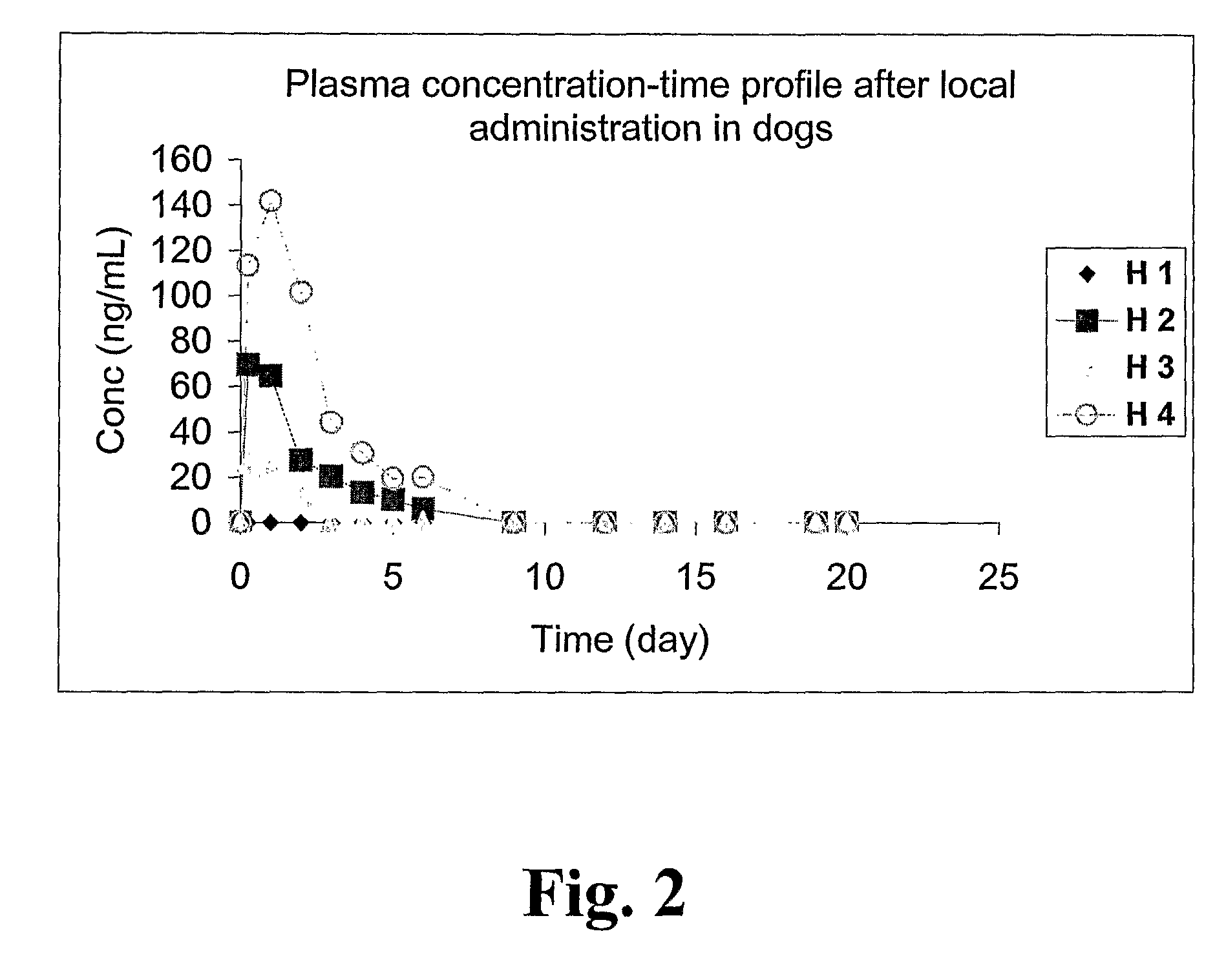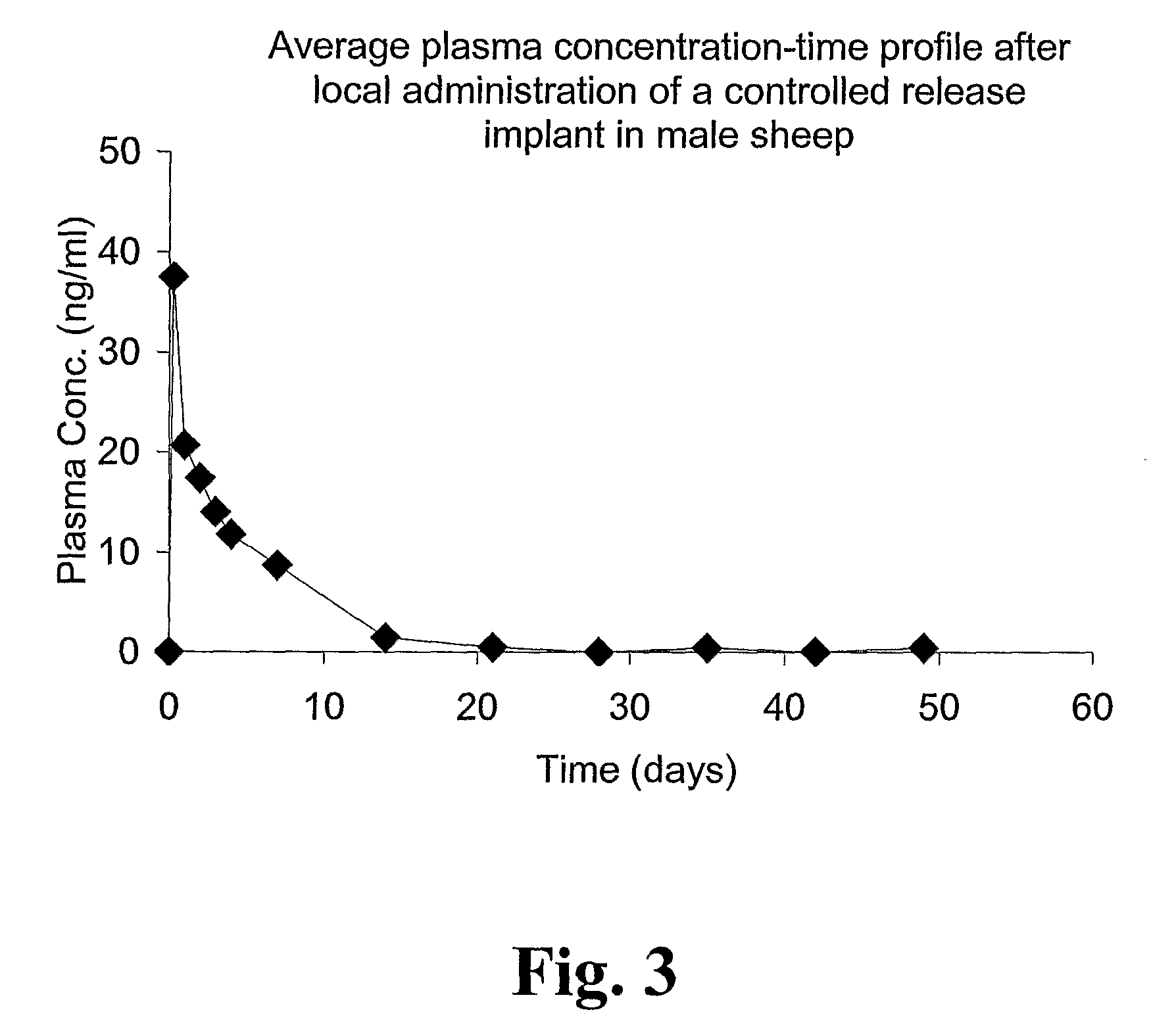Method for Treating Prostate Diseases Based on Local Delivery of Active Substances
a prostate disease and active substance technology, applied in the field of prostate related diseases, can solve the problems of increased mortality due to prostate cancer in the future, extensive side effects, and patients' inability to always achieve satisfactory results
- Summary
- Abstract
- Description
- Claims
- Application Information
AI Technical Summary
Problems solved by technology
Method used
Image
Examples
example i
[0147]This in vivo example illustrates that it is feasible to administer locally into a dog prostate a ceramic-based controlled release pharmaceutical composition with 2-hydroxy-flutamide during anesthesia with current available insertion technologies and ultrasound guidance, and that the method provides a controlled release profile of the active substance at the site of application and action.
Methods and Materials
[0148]First, four male dogs (H1-H4) (Labrador, approx. 1 year of age and weight 30 kg) were given 2-hydroxy-flutamide (25 mg) by single bolus doses intravenously during 30 seconds. The intravenous solution base was sterile saline 54%, sterile polyethylene glycol 400 46% and ethanol (95%) 6%. Blood samples of 1.0 ml were taken from the Cephalic vein at 5, 10, 15, 30, 60, 90, 120, 240, 360, and 600 minutes. The blood samples were immediately centrifuged at 3000 rpm and the plasma samples were frozen at −80° C. until analysis.
[0149]One week later, the same animals were given ...
example 2
[0164]The major purpose of the present animal study was to examine the pharmacokinetics, efficacy and safety of the novel local drug delivery system with 2-hydroxyflutamide, a selective antagonist to the androgen receptor (AR). A ceramic based drug delivery product was administered into an androgen dependent tissue (the bulbourethral gland) in male sheep. In total 11 male sheep were divided into two separate groups. One group was given 2-hydroxyflutamide by the local implant delivery system as a single administration into the bulbourethral gland and was monitored during 2 months. Each sheep in this treatment group received the prostate implant by a single dose of 250 mg. The other group only received ceramic formulation without any active drug substance.
[0165]The implant drug delivery system was inserted locally, via rectum, into the androgen dependent tissue (bulbourethral gland) through sterile needles during rectal ultrasound guidance. The animals were during anaesthesia througho...
example 3
[0171]The overall aim of the current preclinical study was to further develop a novel local implant drug delivery system for specific and targeted anti-androgen therapy in the human prostate tissue. This strategy aims to develop innovative pharmaceutical products useful in the cancer treatment, which significantly contribute to more effective therapies with fewer side effects in various disease states where antagonistic action on the androgen receptor is a central function (such as prostate cancer, benign prostatic hyperplasia).
[0172]The major purpose of the present animal study was to examine the efficacy and safety of the new local drug delivery system with 2-hydroxyflutamide, a selective antagonist of the androgen receptor (AR) as the active moiety in human prostate tissue during various treatment periods in male dogs.
[0173]The dog has been selected as the test model because of its proven suitability in this type of study. The study was performed in 12 male beagle dogs from Harla...
PUM
| Property | Measurement | Unit |
|---|---|---|
| Fraction | aaaaa | aaaaa |
| Fraction | aaaaa | aaaaa |
| Fraction | aaaaa | aaaaa |
Abstract
Description
Claims
Application Information
 Login to View More
Login to View More - R&D
- Intellectual Property
- Life Sciences
- Materials
- Tech Scout
- Unparalleled Data Quality
- Higher Quality Content
- 60% Fewer Hallucinations
Browse by: Latest US Patents, China's latest patents, Technical Efficacy Thesaurus, Application Domain, Technology Topic, Popular Technical Reports.
© 2025 PatSnap. All rights reserved.Legal|Privacy policy|Modern Slavery Act Transparency Statement|Sitemap|About US| Contact US: help@patsnap.com



